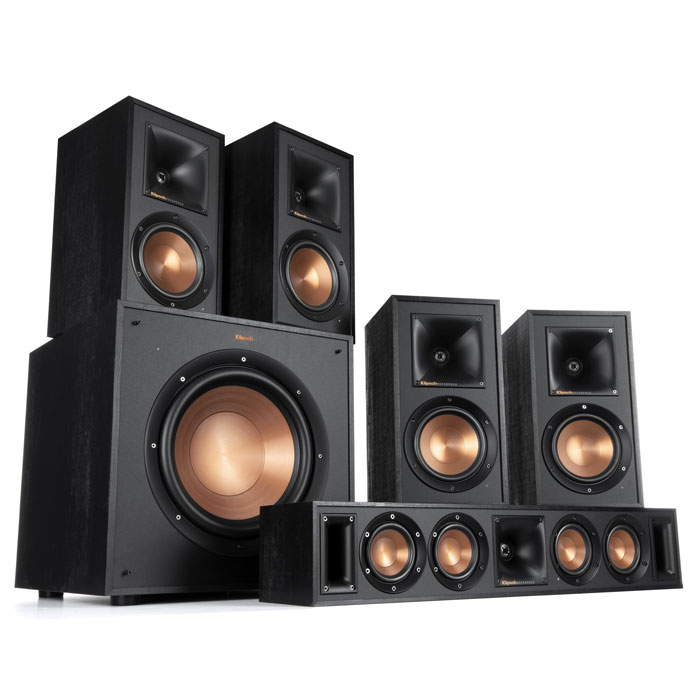
KLIPSCH
Reference Wireless Home Theater System
Incredible sound with simple set up.
PRICE
$2,861
THE HIGH NOTES
- High Quality Wireless Home Theater
- Easy Set-Up
- Great Upgrade Path

Company & Product Overview
When you think about iconic American audio companies, the list is pretty short. Klipsch would certainly be in most music lovers' top 5 if not the very top. Their Heritage speaker products have been bringing smiles to faces and as they like to say “waking the neighbors” for decades. With their 70+ years of audio history, they produce a wide range of products for music lovers of many types.
As they become more successful they have entered categories beyond conventional speakers. Their move into headphones has been a great success with lots of great-sounding choices.
Klipsch has a goal to expose their hallmark sound to as many music lovers as possible. They have felt, as many speaker companies have for years, that physically having to wire speakers up to an amplifier is a limiting factor to some people wanting music in their homes. This is especially true when you consider how many connections a typical home theater has from a speaker standpoint.
WiSA is a trade group formed in 2011. WiSA is short for wireless speaker and audio association. They set out to make standards for the new world of wireless audio. Products adhering to the WiSA standards have not exactly been coming out at a rapid pace, but the tech does have some ideas that might interest music lovers. Two things really stand out about the WiSA standards. First, they are all about Hi-Res Audio with their standard being 24bits at 48kHz/96kHz, which as you may know is twice the quality level of a CD and far beyond most streaming services. Their standard also has almost zero latency so you will not have a lip-sync issue with WiSA enabled speakers in a home theater. Finally, the speakers stay fully in sync with each other, have less than 1/1,000,000 of a second variance. That is all pretty impressive!
Shortly after WiSA was introduced to the market, Klipsch partnered with them to develop a line up of wireless home theater speakers. They took some of their better free-standing home theater speakers and added the WiSA wireless technology. As with most things that come out right at the beginning of new technology (remember the early days of HDMI?), there were some problems. To the credit of Klipsch, they stuck with it and through the magic of software updates got the system 100% stable.
Once they had the tech nailed down, Klipsch started thinking about how they could make a WiSA based system with wider appeal. Wireless, if it sounds good, does have its advantages as there are some rooms where it is just flat not practical to string cables all around, especially for the surround speakers.
The new Reference Wireless Home Theater System is basically a cool set of wireless home theater building blocks. Klipsch previewed this system at the 2019 CES show where it won several “best of” show awards. We were lucky enough to get some products before the official release to put them through their paces.
Design & Build Quality
Klipsch took some of the most popular products from their Reference Home Theater series to form the basis of their new Reference Wireless Home Theater System. There are 3 main speaker types in the system, a bookshelf pair of speakers, a center channel, and a powered subwoofer. All three are very well made, just like all Klipsch models.
The bookshelf pair is based on the R-51M, which is a two-way mid-sized bookshelf speaker.
The wireless model adds a “W” to the model name and is the RW-51M. These use the famous Klipsch Tractrix horn coupled with their 5 ¼” spun-copper IMG Woofer. This model, in the nonpowered version, has been a best seller that gives you a ton of performance for the money. It stands about 13” tall, by 7” wide, by 8 ½” deep.
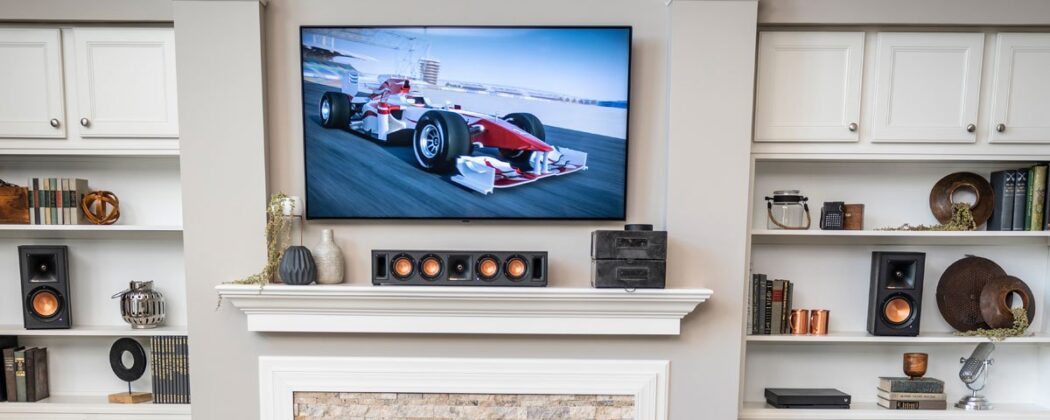
The center channel is derived from their R34C center channel.
R34C is one of the best value center channels on the market. It uses the same tweeter as the R-51M for perfect matching, coupled with 4 of their 3 ½” spun-copper IMG woofers. It has front-firing Tractrix bass ports, enabling it to be put right up against a rear wall. It's just slightly over 5” tall, 26” wide, and 6” deep.
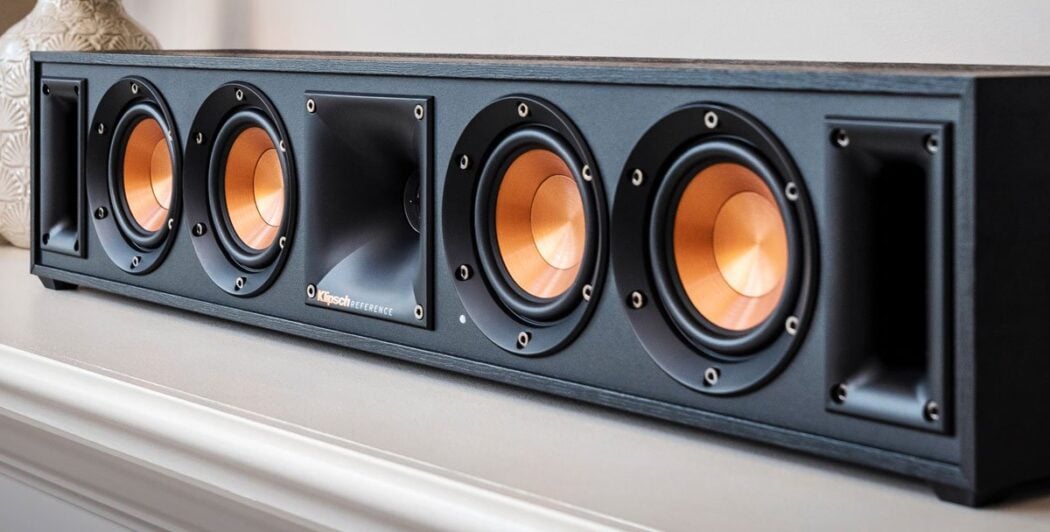
For a great bass foundation, Klipsch picked their R-100SW sub.
Again, this is a super popular model in the Reference series with its 10” spun-copper IMG woofer that provides pretty amazing deep bass for its modest size of what is roughly about a 14” cube.

Features & Technology
The idea of the Reference Wireless Series was to take these three great models and turn them into a system that would be the easiest home theater system ever to set up. To do this, they have to be self-powered, which has another benefit besides eliminating speaker wires.
Speakers with the amplifier built-in have always been a favorite of ours at Audio Advice. They have a lot of advantages over conventional speakers. The catch is, there are just not that many of them on the market, although things are changing with wireless becoming more popular.
When you make a speaker designed to be driven by an amp of some sort, as a speaker designer, you have no idea what kind of amp will eventually get connected up to your speaker. This forces you to make some design compromises to give it great flexibility. However, a powered speaker is a completely different animal. With a self-powered speaker, you design the built-in amp to be a perfect match to the speakers it is driving. You also do not have to use passive crossovers (the part that sends the bass to the woofer and treble to the tweeter). An electronic crossover is typically used which sounds better and is much more efficient. Finally, you’ll normally get one amp specifically made for the bass drivers, and another made for the tweeter for the ultimate in transparency. So not only does wireless eliminate speaker wires, it normally makes the powered wireless version sound even better than the one that requires an amplifier.
The Klipsch Reference Wireless Home Theater speakers have taken what was already a great sounding set of speakers, added WiSA wireless and perfectly matching amps.
Another big advantage is the lack of latency. For watching normal TV and movies this is no big deal, but for serious gamers, it is hugely important. You’ll respond better during the game if the picture and sound are in perfect sync which is exactly how WiSA audio systems perform!
WiSA wireless technology is pretty interesting right now in the way it is implemented. There are three parts to a WiSA system. Obviously you need the wireless speakers, but they will not work without what is called a WiSA transmitter. While you only need one of these per system, you must have one in place. The one Klipsch recommends for theirs is the Axiim Link which sells for $229. You then need a device where the sound comes from. That’s right, with WiSA you can’t just Bluetooth or WiFi connect to your wireless speakers. There is a good reason for this. By using the WiSA transmitter, you are not dependent on your network for transmitting audio data. It's totally separate, which is how it can have Hi-Res with such low latency and perfect sync. However, the drawback is, the audio source device needs to be part of the WiSA alliance.
Right now there are three ways to set up the Klipsch Reference Wireless Home Theater System:
1)- Make an XBOX One X or S the heart of your system. An XBOX One is very flexible with it’s the ability to do gaming, play all formats of Blu-Ray discs including 4K, and its full feature set of built-in streaming apps. You can connect an Axiim Link to the XBOX One and have all sorts of WiSA wireless speaker option from Klipsch to choose from
2)- Use a new 2019 LG OLED or NANO CELL TV. In this situation, the Axiim Link connects to the TV and you would use the TV for streaming video and audio, or switch to any other sources connected to the TV.
3)- Use a Mac or Windows 10 or higher PC as your video operations center. This way leans a little more towards the tech geek side, but just like with the XBOX One set up, the Axiim Link connects to the computer and talks to the wireless WiSA speakers.
As we got further down the WiSA rabbit hole, we discovered some pros and cons to each method.
While the LG TV method seems the most straight forward, it gives you the least amount of possible options for your wireless Klipsch system.
The potential options in the WiSA world are:
2.0- A pair of the RW-51M’s used in stereo
2.1- A pair of the RW-51M’s used in stereo with the RW-100SW sub added for deep bass.
3.0- A pair of the RW-51M’s used in stereo with the RW-34C center channel
3.1- A pair of the RW-51M’s used in stereo, the RW-34 center channel, and the RW-100SW sub for the deep bass
5.0- A pair of the RW-51M’s used in stereo, the RW-34 center channel, and another pair of the RW-51M’s used for the surrounds
5.1- A pair of the RW-51M’s used in stereo, the RW-34 center channel, another pair of the RW-51M’s used for the surrounds, and an RW-100SW sub for the deep bass
7.0- A pair of the RW-51M’s used in stereo, the RW-34 center channel, another pair of the RW-51M’s used for the surrounds, and a third pair of RW-51M’s added for the rears.
7.1- A pair of the RW-51M’s used in stereo, the RW-34 center channel, another pair of the RW-51M’s used for the surrounds, a third pair of RW-51M’s added for the rears and an RW-100SW for the deep bass.
These are pretty typical home theater system options as well, and it's pretty cool to be able to start out small and add speakers for a more immersive experience without having to add any more wires. With the single transmitter, these range in price from $1028 to $3889.
The XBOX and computer setups give you all of these options, but with an LG TV, you have a choice of 2.0 or 5.1. Now granted those are probably by far and away the most typical use cases, but you are limited to those for now (think future software updates). Also, LG does not have a big choice of music apps available. This could change but right now it is only Spotify and Pandora. Probably the best way to get your music into the LG TV scenario is with an Apple TV and Airplay2 or a Chromecast. Either of these would let you get music from your phone. We should note that like the XBOX and computer solutions, the LG TV would let us choose a music NAS drive on our network for our ripped files as well.
The XBOX One solution gives you more options and the choice of any TV, but you’ll have to use the Axiim app for volume control, which to us, seems a little clunky.
And remember for any of these combinations, you will need the Axiim Link box. Klipsch sent us a 5.1 rig for testing, so we were good to go with an LG TV.
Performance
First, we had to get things set up which was actually pretty straight forward. You plug the Axiim into a USB port on the TV, plug everything in and power things up. The TV sees you have a WiSA system in place, and the very first time, you’ll have to identify which speakers are where for the RW-51M’s. You choose a speaker, push play test tone, and a tone comes out of one speaker. If for instance you chose the right front and the left front is actually playing, you just go to the drop-down menu and tell the system it is actually the left front. You’ll repeat this until everything lines up, but you only have to do this once.
Our next question was, well, what about the speaker levels? For levels, you need to have the Axiim app. And right now, there are no test tones, so you have to just experiment until you feel levels sound about right. Again, this is a one time set up thing, but we sure would have liked test tones. Klipsch tells us this should be updated very soon.
Our listening tests showed what we expected. Klipsch speakers have always had an effortless sound due to their relatively high efficiency, but when you put the amps inside the speakers, it gets even better! We tried the system in both 2.0 and 5.1 and felt for music the RW-51M’s by themselves had excellent imaging and separation of instruments.
For full home theater impact, having identical drivers all around with the same exact speakers for the fronts and surround provides a totally seamless surround sound field. The subwoofer, just like it’s non-WiSA counterpart, can put out good bass slam and has a decent amount of low-level bass detail too.
So the question that came into our heads was, is the WiSA price of admission worth the cost?
The 5.1 Reference Wireless system is $3090 while the passive models you need a home theater receiver for add up to $1376 plus say a $500-$750 home theater receiver, making it roughly $1000 more for the wireless option.
The sound is certainly more effortless with the amps on board, but the exciting part about this system is it will open up great home theater sound to a group of people who just could never wire their space for the full experience. All you need are nearby electrical outlets to power the speakers with and that is it, period! For many lovers of movies, this will allow them to put in a great sounding home theater system without any wiring that also has the super easy ability to move on over to their next living space. This makes it especially attractive to younger people who tend to move around more often than their parents.
While it can take as much as a day to wire up a room for 5.1 surround sound, you can have the Klipsch Wireless Home Theater system up and running in about the same amount of time or less that it takes you to get it unboxed. Plus, we have a feeling WiSA is going to improve over time as more companies adopt it. We would not be surprised to see room equalization come soon, which should just be a software update.
Overall Recommendation
While the Klipsch Reference Wireless system is not inexpensive, it sure solves a lot of problems for many people. If wiring is impossible in your space and you’ve been dying to get the full surround sound experience, it will be akin to finding water on a desert island. We like the fact you can start small and grow with it over time. Plus the fact that it is software-based should allow for some pretty cool updates over time.
HIGH NOTES UNPACKED
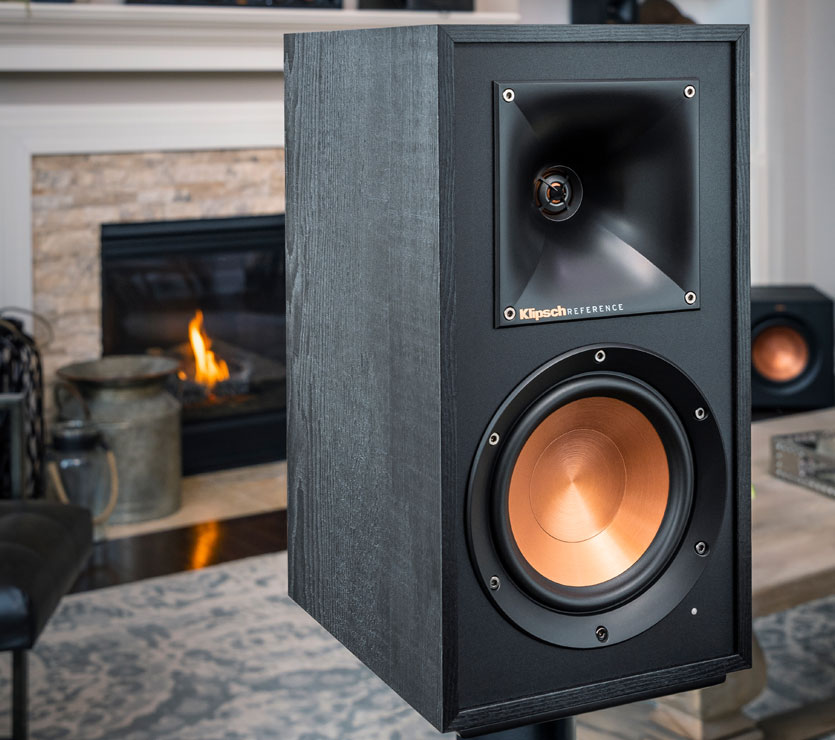
High Quality Wireless Home Theater
Get legendary Klipsch sound in a system that needs no speaker wire, a true breakthrough for home theater.
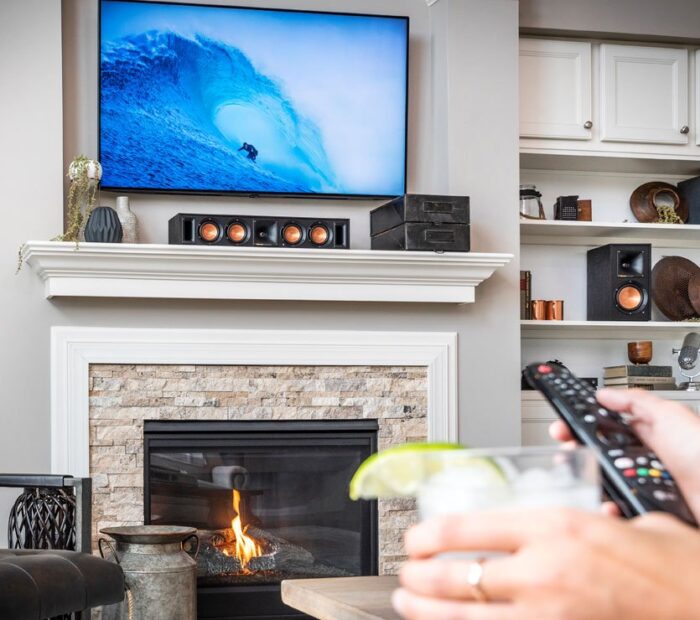
Easy Set-Up
Setting up the Klipsch wireless home theater system should take you less time than it does to unbox it all.
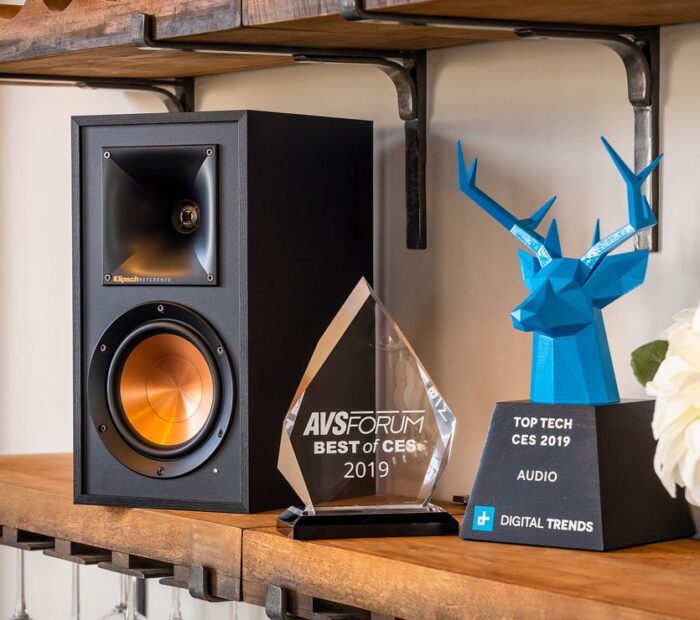
Great Upgrade Path
We love the fact you can start out with just a stereo pair of speakers to improve your TV sound, then upgrade to full surround.
